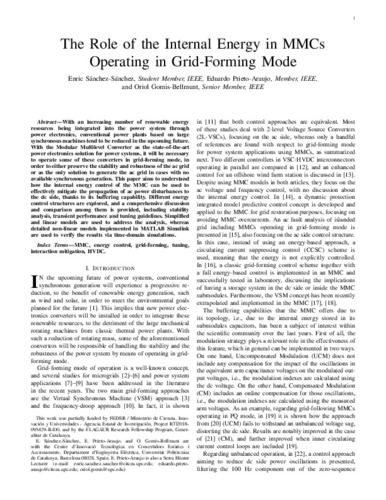Mostra el registre d'ítem simple
The role of the internal energy in MMCs operating in grid-forming mode
| dc.contributor.author | Sánchez Sánchez, Enric |
| dc.contributor.author | Prieto Araujo, Eduardo |
| dc.contributor.author | Gomis Bellmunt, Oriol |
| dc.contributor.other | Universitat Politècnica de Catalunya. Doctorat en Enginyeria Elèctrica |
| dc.contributor.other | Universitat Politècnica de Catalunya. Departament d'Enginyeria Elèctrica |
| dc.date.accessioned | 2020-11-23T08:05:16Z |
| dc.date.available | 2020-11-23T08:05:16Z |
| dc.date.issued | 2020-06 |
| dc.identifier.citation | Enric Sánchez-Sánchez; Eduardo Prieto-Araujo; Gomis-Bellmunt, O. The role of the internal energy in MMCs operating in grid-forming mode. "IEEE Journal of emerging and selected topics in power electronics", Juny 2020, vol. 8, núm. 2, p. 949-962. |
| dc.identifier.issn | 2168-6777 |
| dc.identifier.uri | http://hdl.handle.net/2117/332758 |
| dc.description | © 2020 IEEE. Personal use of this material is permitted. Permission from IEEE must be obtained for all other uses, in any current or future media, including reprinting /republishing this material for advertising or promotional purposes, creating new collective works, for resale or redistribution to servers or lists, or reuse of any copyrighted component of this work in other works |
| dc.description.abstract | With an increasing number of renewable energy resources being integrated into the power system through power electronics, conventional power plants based on large synchronous machines tend to be reduced in the upcoming future. With the modular multilevel converter (MMC) as the state-of-the-art power electronics solution for power systems, it will be necessary to operate some of these converters in grid-forming mode, in order to either preserve the stability and robustness of the ac grid or as the only solution to generate the ac grid in cases with no available synchronous generation. This article aims to understand how the internal energy control of the MMC can be used to effectively mitigate the propagation of ac power disturbances to the dc side, thanks to its buffering capability. Different energy control structures are explored, and a comprehensive discussion and comparison among them are provided, including stability analysis, transient performance, and tuning guidelines. Simplified and linear models are used to address the analysis, whereas detailed nonlinear models implemented in MATLAB Simulink are used to verify the results via time-domain simulations. |
| dc.format.extent | 14 p. |
| dc.language.iso | eng |
| dc.publisher | Institute of Electrical and Electronics Engineers (IEEE) |
| dc.rights | Attribution-NonCommercial-NoDerivs 3.0 Spain |
| dc.rights.uri | http://creativecommons.org/licenses/by-nc-nd/3.0/es/ |
| dc.subject | Àrees temàtiques de la UPC::Enginyeria elèctrica |
| dc.subject.lcsh | Electric current converters |
| dc.subject.other | Energy control |
| dc.subject.other | Grid-forming |
| dc.subject.other | HVdc |
| dc.subject.other | Iinteraction mitigation |
| dc.subject.other | Modular multilevel converter (MMC) |
| dc.subject.other | Tuning |
| dc.title | The role of the internal energy in MMCs operating in grid-forming mode |
| dc.type | Article |
| dc.subject.lemac | Convertidors de corrent elèctric |
| dc.contributor.group | Universitat Politècnica de Catalunya. CITCEA - Centre d'Innovació Tecnològica en Convertidors Estàtics i Accionaments |
| dc.identifier.doi | 10.1109/jestpe.2019.2961774 |
| dc.description.peerreviewed | Peer Reviewed |
| dc.relation.publisherversion | https://ieeexplore.ieee.org/document/8939444 |
| dc.rights.access | Open Access |
| local.identifier.drac | 28895418 |
| dc.description.version | Postprint (author's final draft) |
| local.citation.author | Enric Sánchez-Sánchez; Eduardo Prieto-Araujo; Gomis-Bellmunt, O. |
| local.citation.publicationName | IEEE Journal of emerging and selected topics in power electronics |
| local.citation.volume | 8 |
| local.citation.number | 2 |
| local.citation.startingPage | 949 |
| local.citation.endingPage | 962 |
Fitxers d'aquest items
Aquest ítem apareix a les col·leccions següents
-
Articles de revista [157]
-
Articles de revista [226]
-
Articles de revista [884]


